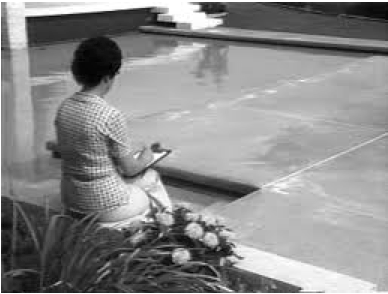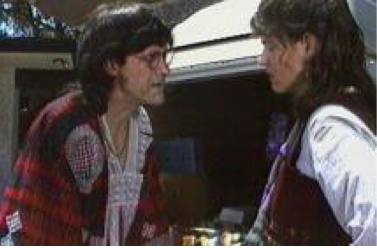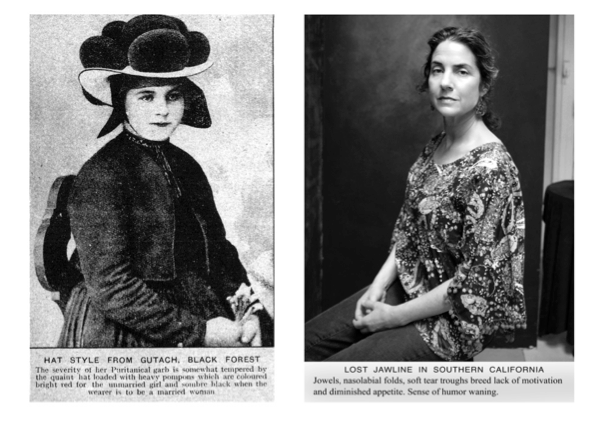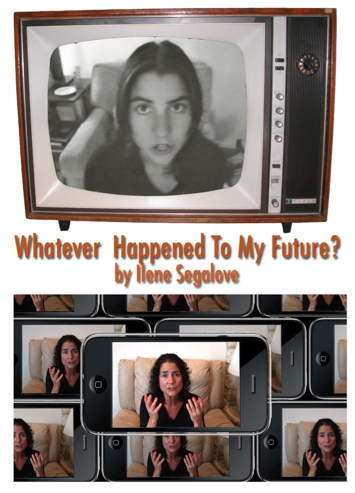Travelling Feministe
Tobi Maier on Ilene Segalove
Travelling Feministe, Forum des Images, Paris, June 21, 2013
Thank you to Travelling Feministe for making this evening possible and for La Galerie in Noisy-le-Sec for inviting me to this residency here in Paris and for realizing the exhibition THE SECOND SEX - A VISUAL FOOTNOTE, which is on view at La Galerie through July 13, 2013[1].The exhibition includes works by Anne-Mie van Kerckhoven, Marianne Wex, Ilene Segalove and a series of films that are part of the archives of Centre Audiovisuel Simone de Beauvoir. I would also like to extend my sincere gratitude to the Centre audiovisual Simone de Beauvoir for supporting my research there and for helping us to select eight titles from the archive for our exhibition. I am profoundly thankful to Emilie Renard, Nicole Fernandez Ferrer, Giovanna Zapperi, Elisabeth Lebovici for their precious advise and support for THE SECOND SEX - A VISUAL FOOTNOTE and finally thank the curator and critic Estelle Nabeyrat for joining me here at Forum des Images.
Tonight we are introducing Ilene Segalove, an American artist, little known here in Europe but also in the United States. She is part of the exhibition in Noisy-le-Sec with two film works Mom Tapes (1974-1978) and Whatever happened to my future (1972-2012) as well as a photographic diptych entitled All my pants (1974) and reproduced in the form of a wallpaper.
|
Ilene Segalove is an artist, author, a teacher and an independent National Public Radio (NPR) producer. She was born in 1950 in Los Angeles and now lives in Santa Barbara, California. Segalove studied Communication Arts at Loyola University in Los Angeles and received a degree in Fine Arts from the University of California in Santa Barbara where she started studying in 1968. Recent exhibitions include THE DISSATISFACTIONS OF ILENE SEGALOVE at Andrea Rosen Gallery New York (2010); Under the Big Black Sun: California Art 1974–1981 at MOCA, Los Angeles (2011/2012); The Imminence of Poetics, 30th São Paulo Bienal (2012) and a one day micro-exhibition which I organized in February together with Cecilia Groenberg and Jonas (J) Magnusson at OEI Colour Project in Stockholm (2013). During the early 1970’s Segalove attended classes at CalArts with John Baldessari, together with figures such as Matt Mullican, David Salle and James Welling who became later well known as protagonists of the so called Pictures generation. Segalove was a member of the group Telethon, which she founded with Billy Adler, John Margolis, and Van Schley. Together with Telethon she designed installations featuring commercial TV collages and undertook an intensive study of such popular-culture icons as ‘television preachers, ice cream cones and the Madonna Inn, a San Luis Obispo, California, masterpiece of kitsch’. Telethon’s installation “TV Environment” brought living room furniture, a refrigerator full of TV dinners and a television set playing tapes of old TV programs to the University Art Gallery at the University of California Santa Barbara in 1972. Following this experience Segalove guest edited an issue of Radical Software: The TV Environment (1972). As part of her work as an independent National Public Radio producer she has developed anthologies of technology in the American household with plays such as Appliances, LP’s, TV, Satellite or Life before the computer or topics typical for young women such as Shopping at Mom’s, Mammograms or Boys. In their style of narration they are akin to her video works. I did not know anything about Segalove’s work until 2010 when I walked into the rear space of the Andrea Rosen gallery in New York City. The collector Dean Valentine had organized a small exhibition of Ilene Segalove’s work that brought back to light many pieces produced during the 1970’s. The work struck me with its wit, as well as its political and feminist awareness. The body of works compiled by Valentine seemed so strong that I was surprised Segalove had not been included in the then so much discussed Pictures generation 1974-1984 show, on view during 2009 at the Metropolitan Museum of Art, or even one of the major American feminist art anthologies. Perhaps it has to do with the fact that Segalove - as she commented previously - thought she was doing “something else”, art was what “the guys around John (Baldessari)” were doing. When I got in touch with Segalove months later for our research during the 30th Sao Paulo Bienal, it became apparent that a large body of works had been lost or destroyed over the time of her career. She was still holding a few and a gallery in Chinatown of Los Angeles was dealing with her work, including some new editions. For me one of the doubts that occured during our research trips visiting artists studios, institutions, museums and collections throughout the Americas, was why women artists are so much in the minority in a generation of figures that graduated from art schools in the 1970’s? This question suddenly returned in the midst of the sunny art scene of California. I was thinking of the warehouses of Paul McCarthy’s studio space in contrast to the lost art of Ilene Segalove. Working with video since 1972, when she bought a portapack Sony camera from Nam June Paik's girlfriend, Ilene Segalove was initially "offended by [video's] invasive quality and seduced by its power”. A self-described "child of Beverly Hills," Segalove began pointing the camera at "familiar things", producing quasi documentaries about her family (Mom Tapes, 1973-75) and about American TV culture (TV is OK, 1976). Mom Tapes has been almost entirely shot at the family home in Beverly Hills and introduces the relationship between the young artist and, well, her mother.
Mom Tapes (1973-75), black and white video, sound, 29 min, courtesy the artist
In a later work, Riot Tapes (1984), Segalove narrates her life around 1968 as a student in a politicized California university environment and depicts herself in a romance with her anorexic boyfriend Ricky who is trying to evade the draft to Vietnam.
detail from exhibition catalogue Why I Got Into TV And Other Stories, Laguna Art Museum, Laguna Beach, 1990, p. 49
Segalove said about The Riot Tapes: “they were done to put my pseudo-college life into some kind of shape, to honor my old boyfriend and his ideals, and to build some humor into a pretty serious time.” In these films Segalove appears as narrator telling stories with a distinctly dry sense of humor underlining their cultural criticism.
Riot Tapes (1984), Color video, mono sound, 30 min., courtesy the artist
Besides her films, Segalove has produced collages and photomontages that question the arts’ potential for social change and their role as sophisticated entertainment. The best know is the collage produced as chromogenic print and entitled Today’s Program: Jackson Pollock, “Lavender Mist” (1973)[2]. Segalove inserted a color reproduction of a Pollock painting into a black-and-white photograph of airline passengers watching an in-flight movie. The Pollock painting appears on the drop-down screen. The screen, in turn, obscures the head of a flight attendant standing behind it and casts a harsh shadow, leaving her visible only from the shoulders down. Today’s Program: Jackson Pollock, “Lavender Mist” is also reproduced on the cover of Reese Greenberg, Bruce W. Ferguson and Sandy Nairne’s book Thinking About Exhibitions (Routledge, 1996)
As the New York-based artist John Miller has eloquently written in a text for ArtForum (October 2011): “Today’s Program seems like a one-liner [. . .] until one begins to parse the joke. The first thing to strike the viewer (apart from the spaciousness of the seats in what appears to be economy class) is the absurdly rapt attention passengers have given over to the improbably placed painting. The impression of group hypnosis within the airline cabin is reminiscent of the cover for Black & Red’s 1970 edition of Guy Debord’s Society of the Spectacle. That image shows an audience for a 3-D movie, each person staring straight ahead, each wearing the same kind of outlandish cardboard glasses. To state the obvious: Nobody looks at a painting like that, no matter how good it is. For her part, Segalove seems to ask, What kind of attention does an avant-garde artwork, versus popular entertainment, deserve and demand? In short, vis-à-vis mass culture, how and by what means has the avant-garde devolved into a form of cultural mannerism?” In a recent series, Secret Museum of Mankind (2011), which was exhibited for the first time during the 30th Sao Paulo Bienal, Segalove has used herself as the ‘aging model’. In ironic and humorous photo-narrative panels she examines her wrinkles and compares herself to women documented in a so-called anthropological collection from a 1937 textbook entitled Man’s Secret Museum. Segalove repeatedly objectifies herself as a retouched self-conscious model, mimicking the pathos and elegance of sixteen global females. The work exemplifies the Warburgian atlas in a way that Segalove creates an analogy between herself and women in similar age range from other geographical contexts and in accpmapnying text labels that integrate the five panels comments on issues of gender and aging.
Secret Museum of Mankind (2011), 5 photographic panels, 99.06 / 73.7cm each, detail, courtesy the artist
In her recent work Whatever happened to My future? (1972-2012) one encounters a montage of animation collage and recorded footage. The film combines footage from 1972 and depicts the young artist conversing with herself today, somehow reminiscent to the mood of the earlier Mom Tapes where Segalove converses with her mom. In contrast to Riot Tapes or Mom Tapes however, Whatever happened to my future? features no voice over but the artist literally faces the spectator. During the approximately 12 minute long film, Segalove looks back to personal and sociopolitical developments from the last 40 years of her life. The animations in the film seem to have been intended to enliven the material and also make the heavy undertone a bit self-effacing and create effects that are akin to a cartoon. For Whatever happened to My future? Segalove chose a kind of funky production, the animated mouths of the young artist speaking aren’t quite right and the video has been produced with the artist todaysitting in an arm chair in her living room - without proper lighting or makeup. In a recent exchange Segalove noted, that ”I wanted to use my face as a blank palette for a kind of scrapbook of personal history. And using captions below my face made it like ‘fake newsworthy’ stuff as my little life on the one hand isn’t very important.”
Whatever happened to My future? (1972-2012), digital collage, dimensions variable, courtesy the artist
Whatever happened to My future? Conjures associations with self help manuals and this is how this work connects us to this other activity of Ilene Segalove as the author of 40 Days and 40 Nights: Taking Time Out for Self-Discovery OR More List Your Self: Listmaking as the Way to Personal Discovery OR Risk Your Self: Listmaking as the Ultimate Path for Personal Change OR Unwritten Letters: Letter Writing as a Way to Resolve the Unfinished Business of Your Life - all books Segalove published alone or in collaboration with others between 1998 and 2009, her “bread and butter”, as she says. This publishing work creates an interesting analogy to German photographer Marianne Wex’s current parallel activity. Wex, another artist participating in the exhibition THE SECOND SEX - A VISUAL FOOTNOTE is organizing self healing workshops (http://www.marianne-wex.de/) in and around Germany. I have asked Ilene to select a clipping from one of her books. This little story is from one of Segalove ‘self improvement’ books titled SNAP OUT OF IT: 101 Ways to Get Out Of Your Rut and Into Your Groove, published by Red Wheel Weiser Conari Press in 2004. According to the artist and writer “It is a collection of ways to cool out or tune up depending if you are a Spinner (too fast) or a Zombie (too slow). It is sprinkled with illustrations And quirky true personal stories about health and transformation.”:
Had I been exposed to someone who was sick? No. |
[1] A publication can be downloaded here http://www.noisylesec.net/kiosque/_519cdf63e2855.pdf
[2] Today’s Program: Jackson Pollock, “Lavender Mist” (1973) was exhibited in the 30th Sao Paulo Biennial, there reproduced in life size as a wallpaper. One of the three original prints (sized 50.8/60.9 cms) is in the collection of the Metropolitan Museum in New York City.












